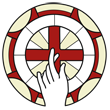A partire dal 1694 all’antica intitolazione di questa cappella alla SS. Trinità viene unita quella di San Giuseppe.
Sulla parete sinistra si conserva un affresco quattrocentesco praticamente integro della Trinità: al centro della raffigurazione vi è il Padre Eterno che sorregge il Cristo crocifisso con una colomba che gli sovrasta il capo, sul lato sinistro si vedono i santi Nicola e Bernardo, mentre sul lato destro i santi Pietro e Francesco; nella parte superiore sono dipinti l’Angelo e la Vergine Annunciata.
Sulla parete di fondo è presente il frammento di un affresco cinquecentesco con un personaggio in armatura inginocchiato accanto a un giovane; a fianco del quale vi è l’immagine trecentesca di san Bernardo da Mentone.
Sulla parete destra sono rappresentati san Secondo (sulla destra) e un santo vescovo di incerta identificazione (sulla sinistra), databili anch’essi al XIV secolo.
Since 1694, the dedication of this chapel to the Holy Trinity has been joined with that of Saint Joseph.
On the left wall, there is an almost fully intact 15th-century fresco of the Holy Trinity: at the
center of the depiction is the Eternal Father supporting the crucified Christ who has a dove
above His head. On the left side, Saints Nicholas and Bernard are visible, while on the right
side, saints Peter and Francis are portrayed. In the upper part, the Angel and the Virgin
Annunciate are painted.
On the back wall, there is a fragment of a 16th-century fresco with a figure in armor kneeling
next to a young man, alongside the 14th-century image of Saint Bernard of Mentone.
On the right wall, Saint Secundus (on the right) and an unidentified saint bishop (on the left)
are represented, both dating back to the 14th century as well.
